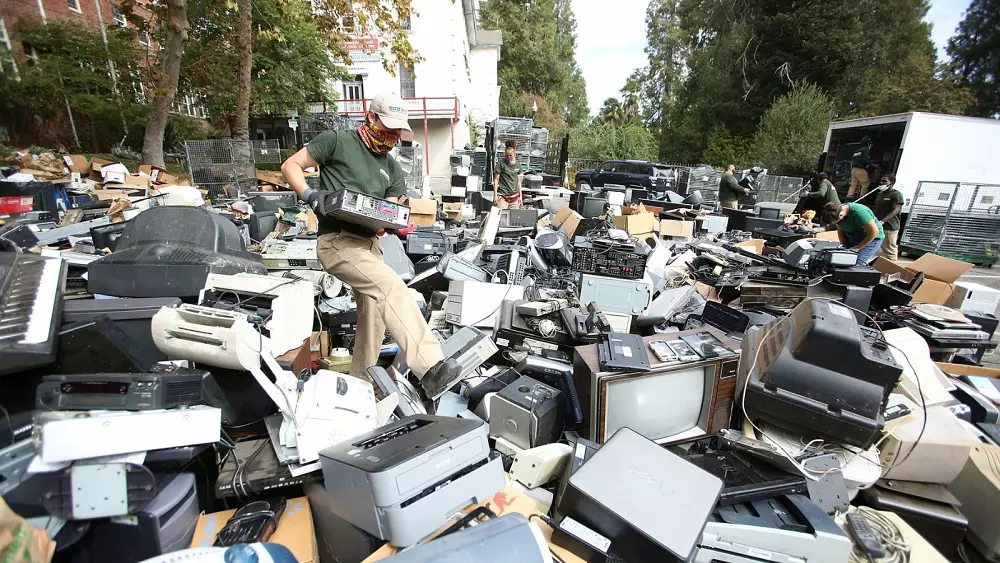[ad_1]
The world has a rising drawback with digital waste. Electronics are in all places in our day by day lives, from smartphones and computer systems to kitchenware, toys and wearable gadgets..
The WEEE Discussion board (Waste Electrical and Digital Gear Discussion board), a world not-for-profit, estimates that greater than 5 billion cell phones might be thrown away this yr alone.
If these telephones had been piled on high of one another, the stack could be 50,000 km excessive – one-eighth of the best way to the Moon.
In keeping with WEEE, households throughout the EU personal on common 74 digital merchandise, 17 of that are mendacity unused in our drawers and closets. Most of those are small shopper electronics akin to headphones, cables, exterior laborious drives and smartphones.
“Folks have a tendency to not realise that each one these seemingly insignificant gadgets have quite a lot of worth, and collectively at a worldwide degree symbolize huge volumes”, WEEE director common Pascal Leroy stated in an announcement on Worldwide E-Waste Day (Oct. 14).
They’re additionally the most certainly to be tossed away and certain for landfills or incineration as a substitute of being correctly recycled.
Europeans are the largest producers of e-waste
The Worldwide Telecommunication Union (ITU), a United Nations company, screens e-waste intently. In its newest report on international e-waste, it estimated that in Europe, an individual generated greater than 16 kg of e-waste in 2019 – the world’s highest price of e-waste era per capita.
Oceania got here second (16.1 kg per capita), adopted by the Americas (13.3 kg per capita), whereas Asia and Africa generated respectively 5.6 and a pair of.5 kg per capita.
Nonetheless, Europe additionally has the world’s highest e-waste assortment and recycling price, at 42.5 per cent. Asia ranked second at 11.7 per cent, the Americas and Oceania had been comparable at 9.4 per cent and eight.8 per cent, respectively, and Africa had the bottom price at 0.9 per cent.
However information compiled by the EU exhibits most member states are failing to hit the bloc’s goal of 65 per cent assortment.
There are additionally main variations in efficiency between international locations, as proven on this map (hover over a rustic to see its recycling price).
Croatia leads the best way with a price of e-waste recycling of over 83 per cent. Sellers of electronics within the nation are obliged to soak up the e-waste prospects herald.
The principles state that if a retail retailer has greater than 400 sq. metres devoted to electrical and digital tools, it should guarantee the gathering of small e-waste (as much as 25 cm) freed from cost and with out the duty to purchase new tools.
Additionally it is doable for anybody to request the elimination of all kinds of e-waste free of charge anyplace within the nation.
On the different finish of the spectrum, Malta has one of many worst charges within the EU, with solely 20.8 per cent of e-waste recycled.
A latest UN report blamed this primarily on the absence of a state-of-the-art e-waste assortment infrastructure, competitors from steel scrap collectors and a scarcity of enforcement from authorities.
Environmental nightmare
The e-waste that isn’t recycled finally ends up hoarded in our properties, or tossed within the bin to be buried or incinerated.
Figuring out that e-waste typically accommodates poisonous substances, it’s each a difficulty for the atmosphere and public well being. And although Europe ranks first by way of e-waste era per capita, growing international locations find yourself paying the value.
But, electronics are nonetheless crammed with precious sources akin to uncommon earth supplies, copper and cobalt – and campaigners say rather more ought to be finished to re-use them.
‘Proper to restore’: How you can deal with our e-waste drawback
One of many choices to cut back our e-waste is to restore damaged electronics.
Since March 2021, the EU requires producers of washing machines, dishwashers, fridges and TVs to make elements accessible to skilled repairers for 10 years.
Officers are actually working to increase this “proper to restore” to smartphones, laptops and different small gadgets.
A European Parliament decision adopted in April this yr requires merchandise to be designed “in such a fashion that they last more, will be safely repaired and their elements will be simply accessed and eliminated”.
France has additionally launched a obligatory “repairability” ranking – from 0 to 10 – on a spread of digital home equipment to tell shoppers on how simple it’s to seek out spare elements and get them mounted in the event that they break.
The index already applies to smartphones, laptops, TVs, garden mowers and washing machines, and can quickly increase to dishwashers, vacuum cleaners and high-pressure cleaners.
Earlier this yr, in a serious blow to Apple, the EU determined {that a} single cellular charging port might be used for cell phones, tablets and cameras by 2024. The transfer ought to lastly assist many shoppers untangle the irritating knot of cables that has shaped of their drawers.
[ad_2]
Supply hyperlink

